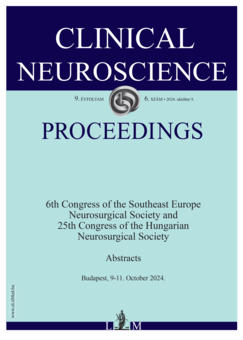The role of neuroendoscopy in the evacuation of non-liquid chronic subdural hemorrhage
ENTZ László1,2,3, ALBERTO Consuegra2, EMANUEL Gutema4, ROBERT Reisch1,3
2024. OKTÓBER 09.
Ideggyógyászati Szemle Proceedings - 2024;9(6)
ENTZ László1,2,3, ALBERTO Consuegra2, EMANUEL Gutema4, ROBERT Reisch1,3
2024. OKTÓBER 09.
Ideggyógyászati Szemle Proceedings - 2024;9(6)
Szöveg nagyítása:

Introduction: Chronic subdural hematomas are lifethreatening conditions whose incidence is increasing due to the frequent use of antiplatelet drugs. The “gold standard” of treatment is surgical relief by means of one or two borehole trepanations and temporary placement of a subdural drain. However, flushing out the subdural space can be problematic if the hematoma has solid parts. In such cases, extensive craniotomies are often necessary.
In this abstract we present the role of neuroendoscopy for hematoma evacuation.
Material/method: The endoscopic technique was used in 15 patients with subdural hematomas. After making a burr hole or an approx. 2 cm “mini-craniotomy”, typically in the area of the widest part of the hematoma, the dura is opened and the subdural space is flushed out as usual. The solid parts of the hematoma are then removed under endoscopic vision using a curved suction device adapted to the calvaria. Depending on requirements, 4 mm optics with a 0°, 30° or 45° viewing angle are used. The visceral membrane is then opened. For closure, the dura is loosely adapted, the burr hole is closed with a titanium plate and a subgaleal drainage is placed under gentle suction.
Results: The endoscopic technique allowed the hematoma to be adequately evacuated in all cases. No intraoperative or postoperative complications have been observed either radiologically or clinically. In particular, there were no new neurological deficits. One patient underwent revision surgery for recurrent hematoma.
Conclusion: The endoscope allows adequate visualization of the subdural space in subdural hematoma and thus safe removal of even solid hematoma parts under optical control. Our results indicate that the residual and recurrent hematoma rate is lower and neurological deterioration is less frequent. Larger numbers of cases are needed to substantiate these encouraging results.
Ideggyógyászati Szemle Proceedings
Despite evidence based institutional protocols being in place in many countries, aneurysmal subarachnoid hemorrhage (SAH) continues to be a major socio-economic burden with many open questions remaining regarding the optimal management of the affected patients.
Ideggyógyászati Szemle Proceedings
Not only other surgical and robotic fields, but minimally invasive procedures in spine surgery have undergone significant development in recent times. A demand emerged from both surgeons and patients to develop and perform these types of surgeries in order to prevent biomechanical and surgical complications.
Ideggyógyászati Szemle Proceedings
Additive manufacturing has gained significant traction in industrial applications due to its high potential when it comes to manufacturing objects with complex geometry.
Ideggyógyászati Szemle Proceedings
Arteriovenous malformation (AVM) is an anomaly of blood vessel formation. Numerous models have been established to understand the nature of AVM.
Ideggyógyászati Szemle Proceedings
N,N-Dimethyltryptamine is a natural hallucinogen, the active ingredient of the brew called ayahuasca consumed by Amazonian tribes for spiritual purposes.
Lege Artis Medicinae
Két, a magyar énekkultúrát külföldön is öregbítő, kiemelkedő tehetségű, sokat foglalkoztatott, ám életében a megérdemeltnél kevesebb elismerést kapó, az Operaház örökös tagjává is csak posztumusz − 1991-ben, illetve 2013-ban − emelt énekművész. A „Sugár úti palota” újkori aranykorszakának két oszlopos tagja volt Réti József (1925–1973) és Bartha Alfonz (1929–2013). Mindketten tenoristák, a lírai fach képviselői.
Lege Artis Medicinae
A pajzsmirigy csökkent működése gyakori az idősekben. A hypothyreosis gyakori okai között szerepel a pajzsmirigy autoimmun megbetegedése, a korábbi pajzsmirigyműtét és a radiojód-terápia. A tünetek atípusosak lehetnek, és a szérumpajzsmirigy-stimuláló hormon szintjének mérését a laboratóriumi vizsgálatok részeként feltétlenül el kell végezni. Az emelkedett szérum-TSH-szint megállapítását ismételt vizsgálattal kell megerősíteni.
Lege Artis Medicinae
A „myocardialis infarktus coronariaokklúzió nélkül” olyan gyűjtőfogalom, mely különböző betegségeket foglal magába - ezek közé tartozik a Takotsubo-cardiomyopathia, vagy más néven „összetört szív szindróma”.
Lege Artis Medicinae
Az agyérbetegségek epidemiológiájában, a rizikófaktorok előfordulásában, az akut szakasz reperfúziós kezelésében, de a betegség kimenetelében is találunk a női nemre jellemző sajátosságokat. A klasszikus rizikófaktorok közül a hypertonia, a pitvarfibrilláció, a cukorbetegség és az obesitas nagyobb stroke-rizikót jelentenek nőkben a férfiakhoz viszonyítva. A női nemre specifikus rizikófaktorok ismerete nem csak a terápia szempontjából, hanem a sikeres prevencióhoz is nélkülözhetetlen.
Hypertonia és Nephrologia
A 2-es típusú cukorbetegség gyakori szövődményei a krónikus veseelégtelenség és a krónikus szívelégtelenség. A krónikus veseelégtelenség és a krónikus szívelégtelenség azonban egymás kialakulását és romlását is segíthetik, illetve korábban és súlyosabban jelentkezhetnek cukorbetegség esetén. Továbbá, a krónikus vese-, illetve szívelégtelenség esetén a 2-es típusú cukorbetegség is gyakrabban fordulhat elő.
Chronic subdural hematoma surgical vs endovascular treatment - Institution experience
A krónikus subduralis haematoma angiográfiás osztályozása
1.
2.
3.
4.
5.
Egészségpolitika
Hadiállapotként kezeli és így is reagál a kormány az egészségügy „rendezésére”1.
2.
3.
4.
5.